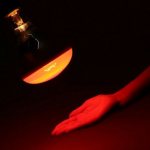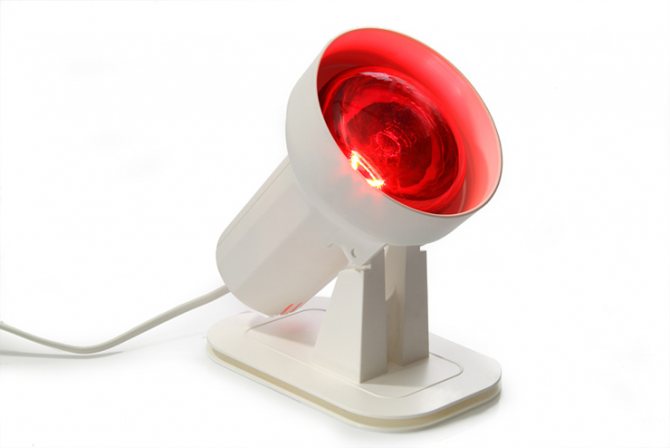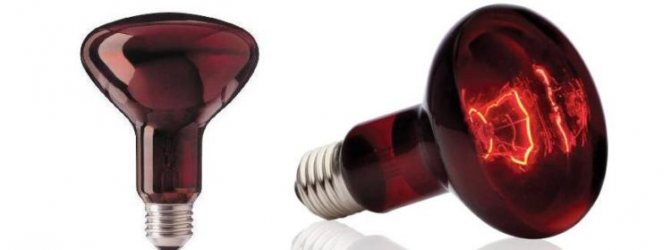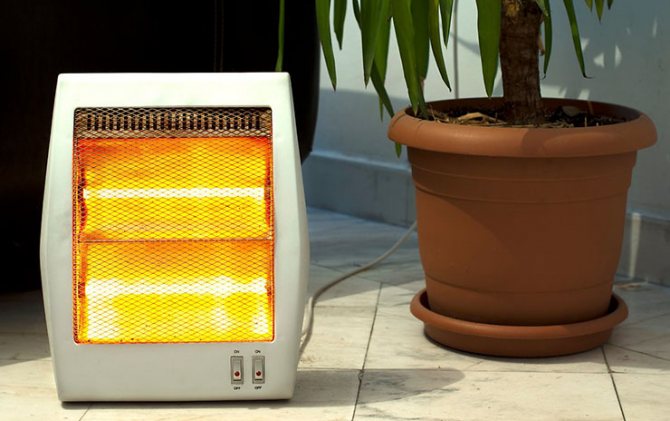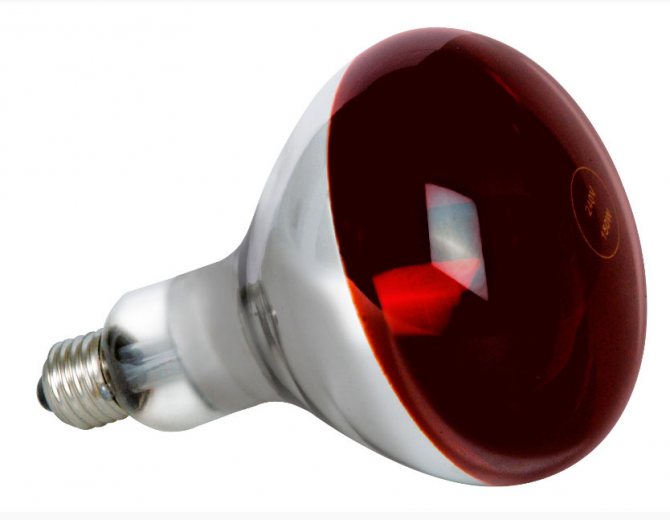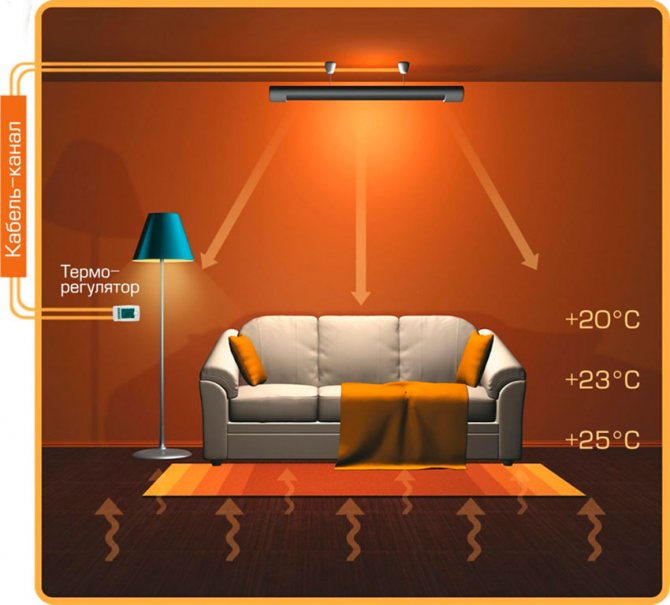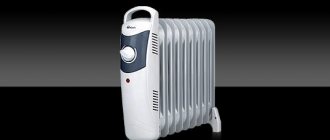Infrared lamp design
Infrared heating lamps are autonomous heating devices that are powered from the electrical network. They are a source of infrared radiation that reaches the surrounding objects and heats them up. The simplest version of the device is presented in the form of a simple glass bulb with a tungsten filament inside. Glass is often stained with a brownish red color. From the inside you can see a mirror coating. Such a light bulb is screwed into a socket, enclosed in a housing or suspended above the heated space.
There are compact infrared lamps for heating rooms, which are made in the form of thin glass tubes - a mixture of argon and nitrogen is pumped into them. The result is a miniature light bulb with a decent heat flow. It functions thanks to a tungsten filament, like an ordinary light bulb, which is designed to illuminate rooms.
An infrared heating lamp is a compact source of infrared radiation with a power of 50 to 500 W, although more powerful devices that are used in heaters can be found on sale. During operation, the body of the device can warm up to high temperatures, for this reason, the cartridge of the device should not be made of plastic, otherwise it will soon melt. Do not touch the infrared lamps, as there is a possibility of getting burned.
How to apply correctly
Before starting the warm-up procedure, install the lamp in a convenient place near a household outlet so that you can comfortably approach it.
How to use an IR lamp:
- Before starting the procedures, a sound timer is always set, since during warming up the person relaxes and can fall asleep. The patient is positioned at a distance of 30 to 50 cm from the heater.
- During the session, the direction of the device or the body is changed in order not to be burned.
- The heating temperature should be comfortable, the heating is carried out until slight reddening of the skin, the duration of the procedure is agreed with the attending physician.
- Usually, a procedure is used from five to ten minutes per session.
It will be interesting to you. Features of measurement of illumination
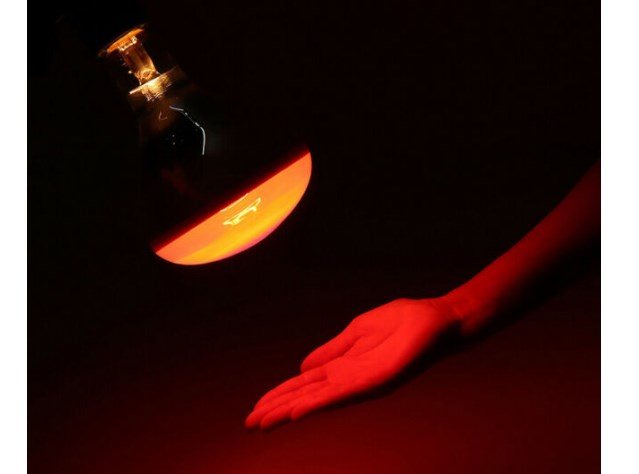
Application procedure
Warnings during use:
- You cannot use the head heating procedure for more than 5 minutes in one session, the interval between procedures should be at least two hours.
- It is forbidden to look at the emitter.
- It is necessary to move or disconnect the device if a burning sensation is felt.
- It is not recommended to use the device in case of injury within the first 24 hours.
- Before the procedure, do not use essential oils, lotions or creams that can cause burns.
- Do not touch the IL when it is hot.
- Do not screw the device too tightly into the base, otherwise it may burst.
- Infrared therapy is contraindicated in certain skin cancers that may be exacerbated by intense light.
Principle of operation
The principle of operation used in infrared lamps was invented by nature itself. Everyone is well aware that the most powerful source of infrared radiation is the Sun. Its rays reach the surface of the Earth and objects located on it, warming them up. As a result, they begin to release heat into the air. It turns out that not the air itself, which is a good heat insulator, heats up from the sun's rays, but the elements of the landscape and buildings that were created by mankind.
Infrared lamps for the home work in a similar way. Infrared rays, instantly reaching any objects, are absorbed by them, after which they are converted into thermal energy. For this reason, by placing your hand under the light source, you can feel the spreading warmth inside yourself. Devices of this type warm up the premises more efficiently than many analogs and at the same time do not waste energy.
The brighter the device shines, the more short-wave radiation it gives, and the further its rays propagate - thanks to this, it is possible to heat rooms with a large area. Longwave models are not as bright, but they radiate more gentle and softer warmth. Radiation from such lamps does not have a detrimental effect on living organisms, including humans - provided that they are used wisely. Several types of devices are used for physiotherapy purposes to treat various diseases.


The principle of operation of heaters with infrared radiation
A feature of equipment with IR lamps is that the heat energy emitted by them is transferred to the surfaces of objects or people in the room, and is not absorbed by the air. This is the main difference between such devices from conventional electric heaters. Heating of objects is carried out only in the field of exposure to lamps. Thus, heat accumulates in solid objects, such as walls, furniture, and then is transferred into the room and warms up the air.
As already mentioned, a red heating lamp emits heat waves only in the area to which it is directed. In this regard, only local heating occurs.
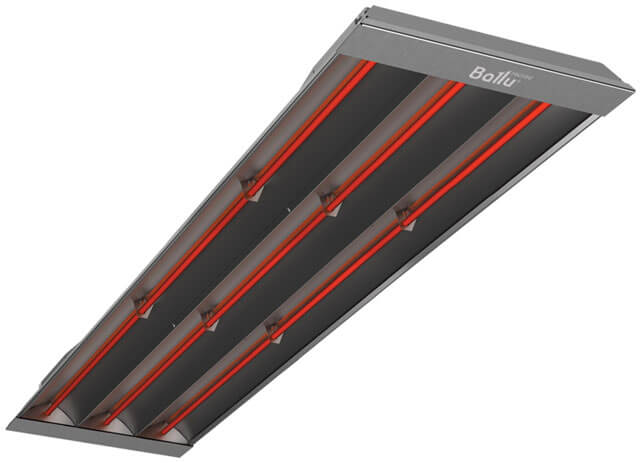

Some consumers mistakenly believe that heating with infrared lamps is advisable only in industrial premises or office buildings, while their home use is not so effective and therefore not justified. However, it turns out that, in comparison with traditional radiator batteries, convectors or oil heaters, heating with incandescent lamps is more efficient and economical. Their operation does not require a supply of fuel, and they consume much less electricity.
A variety of models of heaters with infrared lamps allows them to be conveniently placed in any room. Such devices are compact and do not take up much space. A very convenient option for placing infrared heaters will be installation under the ceiling - so they can cover a large area. Thanks to modern technologies, manufacturers produce devices that can be easily built into the ceiling - this approach not only allows you to effectively heat the room, but also harmoniously fit into the interior design.
Types of IR lamps
Modern manufacturers offer several varieties of IR lamps to choose from. There are four of them:
- without mirror coating;
- with a mirrored coating - they are distinguished by silver bulbs;
- with red mirror finish;
- with blue mirror finish.
The first types of bulbs are superficially similar to conventional incandescent bulbs, but they are also a source of infrared radiation. Powerful luminous heating elements (electric heating elements), which are equipped with halogen infrared heaters, are also lamps, but they are more efficient and are intended for heating rooms with large areas.
- Brain cancer symptoms are early stages of manifestation. Brain tumor treatment.
- Treatment of vegetative-vascular dystonia
- Fruit pomelo - benefits and harms, how to choose a fruit
Other types of bulbs are supplied with a special mirror coating. Such a coating is necessary to improve the efficiency of devices and in order to direct the infrared stream in a certain direction.In the absence of a reflective coating, external reflective elements can be used as it - this is implemented in halogen infrared heaters. Sometimes IR lamps are combined into one structure to create a powerful IR illuminator.
In addition, the traditional infrared lamp in the form of an ordinary light bulb under the E27 base has a specific marking in the form of an abbreviation. The designation "IKS" indicates that the product is not painted in any colors and can be used not only for heating rooms, but also for lighting. The abbreviation "IKZK" indicates the presence of a red color, and "IKZS" indicates that the product is blue. IR devices also differ from each other in several characteristics, which include:
- Chuck type (base). Equipped with a traditional size E27 chuck.
- Wavelength. Depending on this parameter, the devices are long-wave, medium-wave and short-wave.
- Power. Varies over a very wide range.
- Supply voltage. For almost all household IR bulbs, this figure is 220 volts.
Operating principle
The functions of the heating element are performed by a halogen lamp, which emits a stream of waves in the light and infrared range. Such a lamp is a round tube (tubular bulb) approximately 20-50 cm long, filled with halogen - a buffer gas (iodine or bromine), which does not allow the tungsten filament to burn out when heated from the passage of an electric current through it. When connected to the network, the spiral instantly heats up to glow, the tungsten atoms begin to detach from its surface, but in a halogen environment they do not settle on the walls of the tube, but return back to the spiral, increasing its temperature.
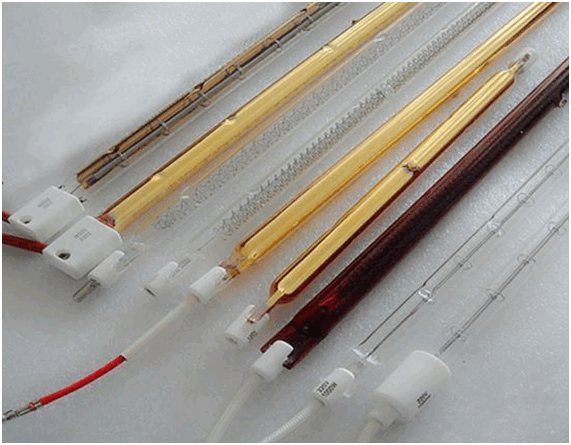

The flux of infrared radiation from the lamp, most often located horizontally in the housing, heats not the air in its path, but the objects it reaches. In this case, not only their surface heating occurs, but also internal heating, as a result of which the heated object begins to give off excess heat to the environment. Thus, the room warms up evenly, without the convection process from the heat source and the accumulation of dust on it. The power regulator allows you to set the desired value, and the low weight of the device allows you to move it as needed to other rooms and use it for both zonal (volumetric, diffuse) and local (subject-focused) heating.
An excessive increase in temperature in a closed room causes a decrease in the required value of air humidity, therefore, when using several halogen heating devices in the room at the same time, it is advisable to install a humidifier as well, which, if necessary, to maintain an elevated temperature, will provide optimal environmental humidity. Uniform humidification of the volume is ensured by turning on the ventilation function available in such devices.


Benefits
The IR lamp has several important advantages that have made it grow in popularity from year to year. They consist in:
- Complete noiselessness of work. Compared to heat guns, infrared radiation spreads without any fans or other devices.
- Maximum efficiency (efficiency). Like most other electric heating devices, it approaches 100 percent - this figure does not reach due to certain laws of physics.
- Spot heating capabilities. This is true for animals that are kept in pens, small cages. For example, "IKZK" is widely used in the field of animal husbandry, where they are used to heat poultry houses, pigsties and other places where animals are kept.
- Compactness. A standard 500W IR lamp is comparable in size to a conventional incandescent lamp.
- Simplest installation.You need to screw the infrared lamp into the socket, and then flip the switch.
- Environmental friendliness. IR devices do not burn oxygen and do not emit any gases into the surrounding area.
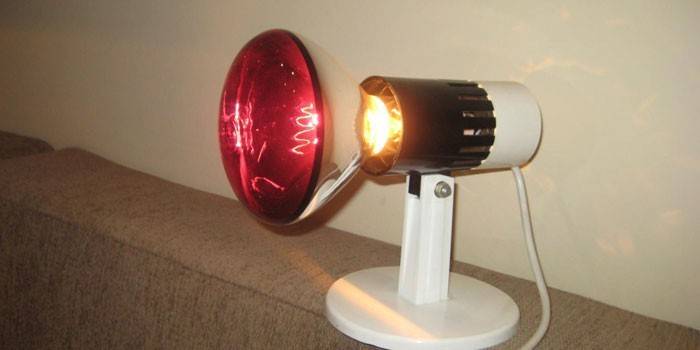

Conclusions and useful video
Infrared heating is hardly cost effective to heat a large home. But it is well suited for additional, spot heating. With its help, it is easy to organize heating where there is only electricity. In addition, ILs are convenient in plant growing, animal husbandry, drying varnishes and paints.
- Similar posts
- TOP 10 LED bulbs in 2020
- What is an LED (device, parameters, marking)
- IZU: connection diagram, types, which one to choose
disadvantages
A device of this type, such as an infrared lamp, is not without its drawbacks. For this reason, be sure to take them into account before purchasing an infrared heating lamp. The disadvantages include:
- High power consumption. This is typical for any heating devices that are powered from the mains.
- The emergence of discomfort with prolonged exposure to light bulbs. In this case, non-compliance with certain operating standards is more often affected.
- High temperature of flasks. There is a risk of serious burns.
Varieties
Modern infrared bulbs come in several types. There are four main types of elements:
- with a gray mirror reflector;
- without a mirror;
- blue coated;
- with a red reflector.
Models without a mirror finish are similar to conventional filament counterparts. However, they emit infrared light. It is worth noting that the light heating heating elements available in the design of halogen heaters also belong to the category of infrared elements, focused on heating large areas.
The rest of the categories of infrared heating lamps are equipped with a special coating of mirror origin. This feature increases the efficiency of the device and allows you to direct the flow in the desired direction. If there is no additional coating, it is replaced by an external analogue, as in halogen IR heaters. Some modifications are a combined system, representing a powerful floodlight.
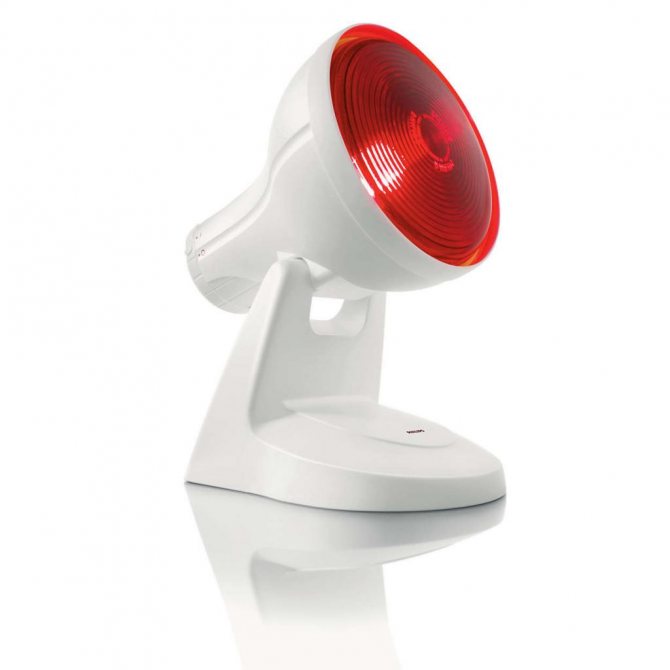

Applications for infrared lamps
Despite the disadvantages, the infrared lamp continues to be in demand for heating various rooms. The scope of its application is wide - it is necessary not only in everyday life, but also in production, in the medical industry, etc. Especially often infrared lamps are used by agricultural workers and people who specialize in breeding livestock and poultry. They also acquired some distribution for heating open areas.
For heating animals
Infrared devices are well suited for livestock breeding, so they are used in chicken coops, pigsties, cowsheds, stables, etc. Infrared radiation to heat chicks helps chicks survive and stay warm. Birds are happy to huddle right under the device, enjoying the heat released from it. In the same way, cages with animals are heated, where a thermal infrared lamp with temperature control can be useful.
Such devices are especially in demand in chicken coops. Their use helps to provide the birds with the necessary level of warmth and create a comfortable atmosphere even in extreme cold. They stop feeling discomfort from cool air and freeze. The immune system of birds grows stronger, and the risk of morbidity among them decreases sharply - this is very important for laying hens, because a comfortable, stable temperature helps them to lay eggs regularly.
The same devices are used in zoos, terrariums and on farms, where newly born animals are deposited in separate boxes, cages.To make them comfortable and warm, low-power bulbs are installed above them. In terrariums where snakes, turtles, reptiles and other amphibians live, a heat point is made using an IR lamp. It is a place where reptiles crawl out to warm themselves. Exposure to radiation for 3-5 minutes will warm up the animals, and the absence of bright light will have a positive effect on their nervous system and will preserve their sleep patterns.
- Progesterone: the norm in women
- Mass Gain Cocktails
- Diet Oatmeal Cookies
For space heating
An excellent basis for an outdoor heater is a halogen infrared lamp. With a short wavelength and low power, relatively large areas are heated with its help. Heating devices, supplemented with such bulbs, are widely used on verandas, terraces, near pools. They are used even in open areas of cafes and restaurants. The infrared rays emitted by them quickly reach people, delighting them with warmth and comfort.
In outdoor conditions, they are almost the only way of heating, tk. conventional convectors, heat guns will be useless. The infrared tube heater is excellent for heating commercial and residential areas. By installing such appliances on a wall or ceiling, you get a good source of heat. A short or medium wave light bulb will quickly create a comfortable atmosphere for people to stay. Heaters of this type are rarely used on a permanent basis - they are often used as ancillary equipment in case of poor main heating.
For sauna
With the help of IR lamps, the body is warmed up from the inside, because infrared waves easily penetrate to a depth of about 4 cm, having a positive effect on joints, skin, and the system of internal organs. The use of such heaters in saunas contributes to weight loss. Excess fluids, along with toxins and toxins, are actively removed along with sweat.
At the same time, blood flow improves, and the body's energy consumption increases, which provokes the burning of calories. With regular visits to infrared saunas, you can successfully fight all sorts of skin lesions, for example, dermatitis, eczema, etc. Staying in an infrared sauna makes the walls of blood vessels elastic, reducing the risk of developing heart and some other dangerous diseases.
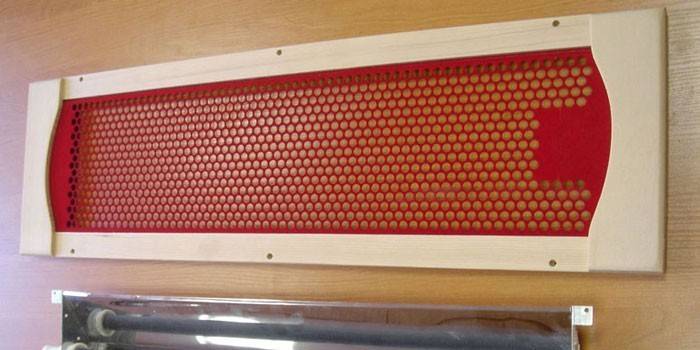

For drying paint and working with plastics
Processing different materials and drying them with an IR lamp is a profitable and practical method, which is used by both small workshops and large paint shops. Lamp drying can be done pointwise: the heat from the device is directed to the area of the object that needs to be dried, without heating its other zones. For example, drying the hood does not heat up the entire vehicle, but only the hood.
When working with plastic, radiation helps it straighten, soften, bend and shape. Additionally, they participate in shrinking, drawing, extrusion of objects from plastic, representing an effective tool. Such bulbs are also used by printing houses, where they use them to free the paper from excess moisture - drying with warming up is faster. The result is high quality printing.
For heating greenhouses
With the help of infrared radiation, the optimal atmosphere in the greenhouses is organized, because the plants receive the same rays from the sun. Such heating will be a plus for the development of crops. For this, a lamp for an infrared lamp is used or single products are adapted, which hang on wires over developing plants. This type of lamp is also suitable for those who grow seedlings on the windowsill. Plants will not lack warmth, lighting. The main thing is not to overdo it with the selection of power, the duration of the backlight.
For treatment
The treatment with infrared light bulbs has been a little forgotten.Previously, infrared lamps were widely used to eliminate pain symptoms, treat osteochondrosis, and pain in bones and muscles. They also helped with flu, throat diseases, acute respiratory infections, skin diseases and high blood pressure, through them they strengthened the immune system, relieved stress, removed bruises, and increased the body's endurance.
Nowadays, treatment with infrared lamps is gradually reviving again. People began to trust pills less, remembering the beneficial effects of physiotherapy procedures. Treatment with infrared rays belongs precisely to the field of physiotherapy. The infrared spectrum is effective in treating acne, which is important for people who are concerned about skin problems.
How to connect an infrared motion sensor to a light bulb?
General recommendations for the installation of the specified equipment:
- the height above the treated area should be from 2500 to 4000 millimeters, depending on the modification of the equipment;
- when choosing a place for installation, it should be understood that the detector is more sensitive to movement across the observation point;
- the combined load power of the lamps is limited (for incandescent lamps - 60-1200 W, for luminescent analogs - 0-600 W).
Most often, sensors are connected to modifications that are mounted in the sockets of spotlights. Installation sequence:
- First, turn off the voltage in the supply network.
- Remove the protective plastic cover.
- Connect the conductors according to the scheme indicated by the manufacturer in the passport of the device.
- The fixing springs are folded back and directed upwards.
- The sensor is placed in a prepared socket, where it is fixed by means of springs.
This completes the installation of the infrared motion sensor. At the end of the work, the equipment is tested and adjusted.
